The idea that colonial governments might foster and fund schools detached from church governance belongs to the 1830s. By then, with the religious diversity of the colonies, it was beginning to seem impossible that the Church of England could by itself provide a dominant ‘public’ school system. There were too many Roman Catholics, Presbyterians, Wesleyans, Congregationalists and more for easy acceptance of such a position. Churchmen such as John Dunmore Lang, a prominent leader of the Presbyterians, effectively opposed the pretensions of the Church of England as an established church and the sole provider of government subsidised schoolhouses. The great failure of the Church and School Corporation in the 1820s, signified the decline of such hopes.
The favoured alternative, by the churches at least, was that each denomination might establish their own schoolhouses with government assistance. By the late 1840s problems with this model of school provision had also emerged, not only from an economic point of view. Robert Lowe’s report (Report of the Select Committee of the Legislative Council (1844) into the schooling of New South Wales promoted the idea of National schools, schools that could be based on Christianity certainly, but not the dogmatic theology of any particular church, denomination or sect. The idea that a “common Christianity” could be extracted from biblical teaching was thought possible by many. If sufficiently accepted, then one schoolhouse in each village or town could be funded.
No longer would colonial governments be faced with supporting three or more schools and teachers in each locality. Opposition to the common Christianity idea was strong, but there were supporters as well. Support waxed and waned at different times and in different parts of the colony, often in response to the views of particular church leaders. Those least concerned were usually local families with children, desperate to have their children educated regardless of religious disputation.
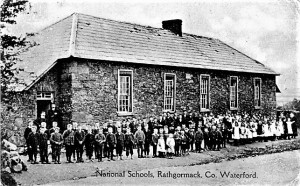
An early National school in Waterford, Ireland. (https://www.rte.ie/)
There was a British Empire precedent for the non-denominational National school, and that came from Ireland. Roman Catholic Ireland was not reconciled to Protestant British rule. The occupying government suppressed schools run by Catholics, imagining that they would harbour rebellion. Another kind of school was required, a ‘national’ school that would be based on common Christianity principles. National schools were established in Ireland from 1831. Textbooks, readers and instruction could each occur on a ‘national’ rather than Catholic foundation. Initially the national schools received fair support from the Catholic Church. Given the size and dominance of the Catholic population, a large number of the national schools were virtually Catholic. That did not mean that curriculum, textbooks and inspection regimes were particularly Catholic.
This accommodation did not last. By the 1870s the Irish National System was failing. New teaching orders such as the Christian Brothers provided low-fee alternatives. Common Christianity was considered more akin to common Protestantism. Its political purpose was to detach the majority population to some degree from the influence of the Catholic Church. In fact, the Irish National system was possibly more successful for a longer period in greater New South Wales (which then included the future Queensland until 1859 and Victoria until 1851) than in Ireland itself.
A governor of New South Wales, Richard Bourke (1831-1837) saw the possibility of the Irish national schools as a future for the colony. At home in Ireland, he was a supporter of such schools before and after his governorship of New South Wales. Nevertheless, in the colony, a coalition of Protestant opposition led by Bishop Broughton of the Church of England saw his plans abandoned, but the idea of national, that is, non-denominational government-assisted schools, did not disappear. The colony’s dispersed rural populations and the difficulty of providing any, let alone several schools attached to each church, in villages and towns demanded a solution. Denominational schools were inevitably small with competent teachers difficult to recruit and pay. School fees were difficult to collect as was the maintenance of enrolments.
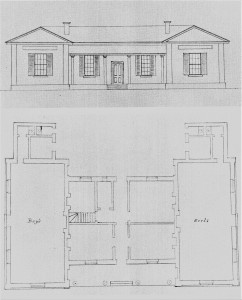
Plan for the Wollongong National School (1837). Source: Sydney and the Bush, p. 39
Schooling the children of Wollongong
The case of Wollongong was instructive. In 1836, despite the opposition, Governor Bourke was able to secure funding for a National school in Wollongong, a growing village to the south of Sydney. Nothing was done until the new Governor, George Gipps began the building of the school in 1840. As soon as this school was commenced the Church of England took action, raising £200 to which the colonial government was obliged to provide a further £200, making the proposed National school to a degree redundant. Then the Catholic Church commenced building its own schoolhouse; the Presbyterians put together a plan, and the Wesleyans were predicted to be not far behind. As Governor Gipps reported back to England:
Religious animosities formerly unknown in the place, have lately manifested themselves to such a degree that I have preferred to leave the Government school empty, rather than by appointing a master to it of any denomination to give fresh cause for dissension. (Gipps to Lord John Russell, 24 October 1840, in Griffiths, p. 71)
Wollongong’s national school remained derelict for many years. The colonial government was obliged to subsidise each of the Wollongong denominational schools. Each of them was small and likely inefficient. Government funds were being wasted. One National school could have done the job.
Under pressure from reduced government revenue, Gipps despaired. Education grants to the churches were reduced but the schooling of colonial children continued to suffer. Bishop Broughton was powerful enough, on behalf of the Church of England in the colony, to fight off any attempt to provide local schools that crossed denominational division.
Towards a national system
The Wollongong problem was played out in many of the settlements in greater New South Wales. The difficulties were so great that the Legislative Council commissioned a report from Robert Lowe, newly appointed by Gipps to the Council. He outlined the problems. Only half the children in the colony were being schooled. The expense of subsidising small denominational schools was not sustainable. Lowe argued: “Wherever one school is founded, two or three others will arise, not because they are wanted, but because it is feared that proselytes will be made; and thus a superfluous activity is produced in one place, and total stagnation in another. It is a system impossible to be carried out in a thinly populated country.” (Lowe Report, 1844, in Griffiths, p. 74)
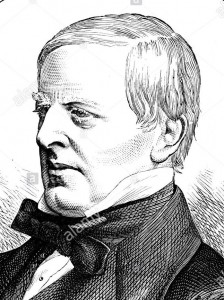
Robert Lowe in later life. Source: State Library of New South Wales
Given the circumstances of the colony there was only one solution according to Lowe, a system of National Education that could include both Catholics and Protestants. Clergy could visit National schools on a limited basis to provide denominational instruction, but ‘ordinary’ school work would be based on subjects that represented a more general “literary and moral education”. A board of national education would approve extracts from scripture for use in this ordinary business of school instruction (the so-called common Christianity). Lowe argued for a central board of national education, not local boards, to supervise schools, and that a normal or model school be established in Sydney for the training of teachers.
Debate over Lowe’s recommendation was vigorous. Strongly opposed was Bishop Broughton, but there was reduced opposition from others. Even the Presbyterian firebrand, and founder of the Australian College, John Dunmore Lang was forced to agree. It had become ridiculous that: “In one small village there were three petty schools, and three scarecrows of teachers, where one good one would have performed the duty with the most perfect case. Under the circumstances … the teacher … was but one degree removed from the keeper of pigs.” (Lang’s comments reported in a public meeting on Lowe Report, 1844, in Griffiths, p. 74.)
Four years later, in 1848, a National system of education was established, but there would be new problems created by the running of two sets of schools. For those believing in the efficiencies and rationality that a system of National schools would bring, there was progress at least.
1848: Two boards established: the dual boards era
Two boards of education, National and Denominational were established in 1848, with another separate Denominational Schools Board for Melbourne. Government funding of schooling was funnelled through each Board. In general, the National Board performed more satisfactorily than the Denominational. Early National Board regulations closely resembled those of the Irish National Board. The advice on the appointment of teachers stated that they should be persons of “Christian sentiment, of calm temper and discretion, should be imbued with a spirit of peace, of obedience to the law and loyalty to the Sovereign …” (Quoted in Waugh, 2019, p. 117.) There was stronger central rather than decentralised control of schools. Teacher training was improved and the availability of schools in the colony expanded.

Headquarters and principal school of the new National schools, Fort Street, Sydney. Source: National Library of Australia
In William Wilkins, hired initially to head the newly founded Model School (becoming Fort Street National School) and later Chief Inspector of the national system, the Board had a leader with a substantial educational vision and bureaucratic ability. A few years later, Henry Parkes emerged as Wilkins’ ally, an effective politician, a powerful supporter of National then public education. He, his newspaper and supporters countered the continuing hostility from the churches and their schools.
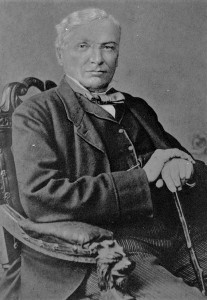
George Rusden, agent of the National Schools Board, in later life. Source: State Library of NSW
George Rusden, hired as an agent of the National Board, was responsible for encouraging the establishment of new National schools in rural communities. He made several great journeys on horseback, one as far north as Moreton Bay through New England, another as far south as Geelong on to Portland through the Melbourne district. The Hunter Valley also received his attention. At local meetings, Rusden displayed textbooks and Board regulations and assisted committees to prepare applications for the opening of schools. He ensured building contracts were let. In the 1849 to 1851 period, 22 National schools were in operation and applications from a further 19 districts were under consideration.
In 1855 there was a report to the Legislative Council of greater New South Wales (now including Queensland but not Victoria) on the state of schooling in the colony. There were plenty of sub-standard National schools existing in rural areas, in little more than wooden huts, but the schools of the Denominational Board were in worse condition. Of the teachers in both systems, 90 per cent from the National system had received training. Only 36 and 43 percent of teachers respectively from Church of England and Roman Catholic schools were trained.
National schools in Victoria
In 1851, Victoria was separated from New South Wales, quickly establishing its own National as well as Denominational boards. The National schools were initially starved of funds but by 1857 they entered a period of growth. Schooling the goldfields populations, as patchy as provision was (including the alarming “tent” schools), could not have occurred to any degree without the National schools. [See entry on Inspector Knowles]
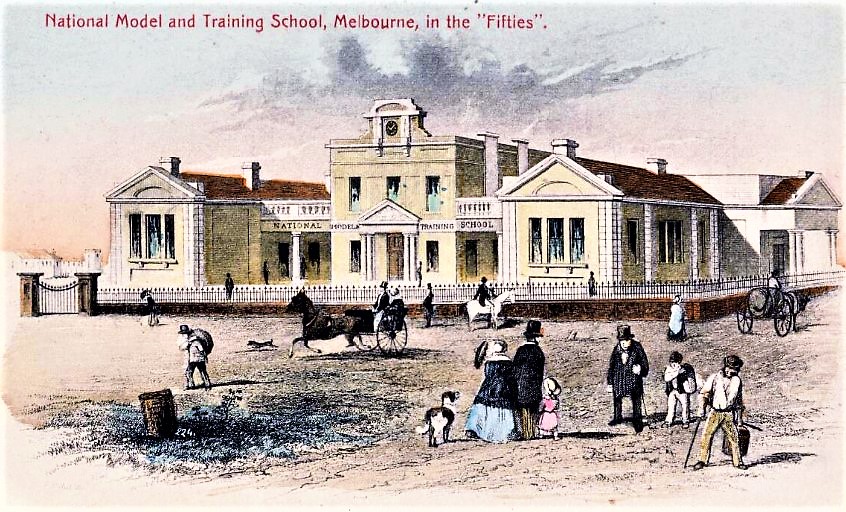
National Model and Training School, 1850s, Melbourne. Source: S.T. Gill (artist), State Library of Victoria
The secretary of the new National Board of Education (from 1852) was Benjamin Kane, a competent administrator and later inspector of National schools, but he and the National schools were not as successful as Wilkins in New South Wales. Arthur Davitt was recruited from Ireland (a recommendation of the Irish National schools commissioners) to lead the National Model School in Melbourne, but he ran into problems as methods of literacy instruction were resisted by some National schoolmasters, and there were also problems with the appropriate use of corporal punishment of students and inspection.
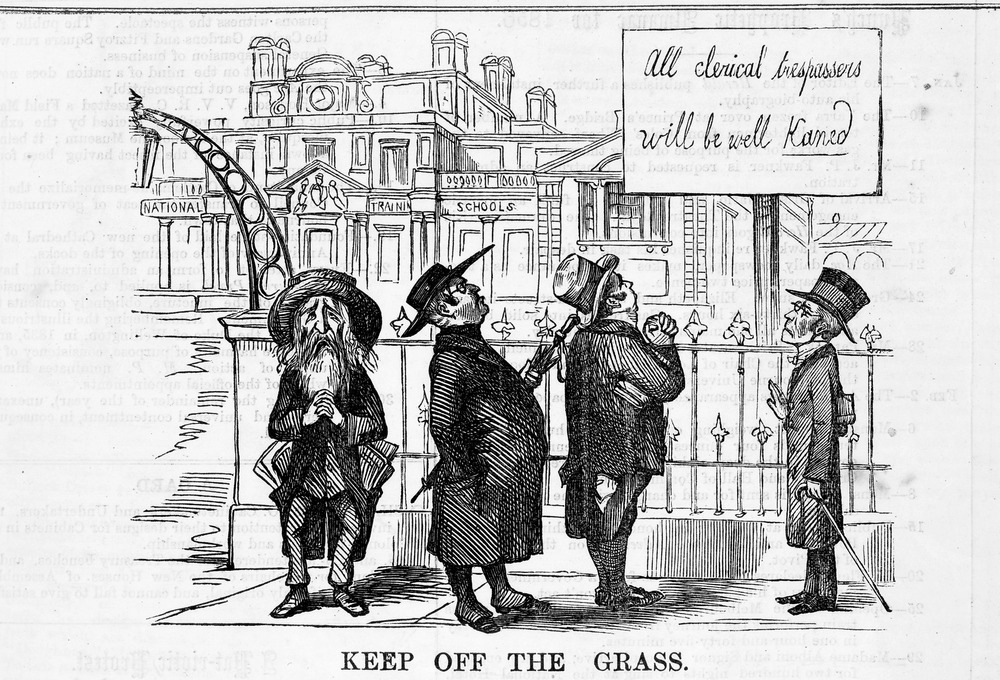
Cartoon of 1855. National schools in Victoria resisted the visitational influence of denominational clergy. Source: State Library of Victoria.
The problems were multiple: they included the work of local school boards, teacher recruitment and setting appropriate salaries, implementing religious instruction and establishing a system of teacher classification. Often these problems played out as National schools’ personnel fought one another. The Victorian governments often showed little commitment to schools other than the denominational. In 1862 the National Board was wound up. All National and many denominational schools became “common schools” governed by a single board of commissioners.
National schools in Queensland
Queensland was separated from New South Wales in 1859. Its National schools survived an early period of hostility from Bishop Edward Tufnell (Church of England) but with the efforts of both Governor George Bowen and the influential Charles Nicholson who had been a National Schools Board commissioner in New South Wales, a Board of General Education was established. Nevertheless, it took another ten years before the National as opposed to the denominational schools began to flourish.
Schools, teachers, curriculum and inspection
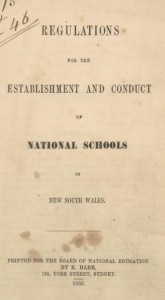
National Schools, Rules and Regulations, New South Wales, 1853. Source: National Library of Australia
By 1850 a system of National schools had been founded across New South Wales, and continuing in the new colonies, Victoria and Queensland. The National schools were initially established through local initiative supported by the National Board. Under William Wilkins’ leadership, regulations were framed. They governed teacher training, and importantly, the management of children’s education.
Monitorialism, as the means of instruction, was to be left behind, though not as speedily in Victoria, nor the denominational schools. In the place of large schoolrooms, classrooms became the school. Students were grouped in terms of age, ability and sex, so students who were similar across these categories were taught together. A new system of apprentice teachers was established. School headmasters would be responsible for training pupil teachers, who would have classroom teaching responsibilities as well. The Fort Street National School had a leadership role across the system as did the Model and Training School in Melbourne.
The National school system signified a major step towards the professionalisation of teaching, substantially rescuing it from the untrained. Inspection of schools occurred, but conditions were so difficult in rural areas that improvement of teaching and accommodation was slow, but it was generally slower in the schools of the Denominational Schools Boards.
The school curriculum improved. The Board was able to import texts and readers used in the Irish National schools, and they were a great advance on many of the texts used previously. The significance of the Irish National Readers forms a separate entry in this Dictionary.
Towards the modern public school
The National schools of New South Wales were re-named public schools in 1866. The National then Common schools in Victoria also became public schools, in 1870.
The two boards system in New South Wales became a single board system in 1866, but there were plenty of problems remaining in creating schools that educated the children of the eastern colonies. Funding remained inadequate, support for National schools in the parliaments of the colonies remained variable. In Wilkins’ view parliamentary approaches were too often “deranged and obstructed”, the denunciations by church leaders against National schools as “godless and infidel” continued, but the schools were remarkably popular. In 1850 there had been 39 National schools with 2,725 students. In 1865 there were 263 schools in New South Wales (now without Queensland and Victoria), with 17,433 students. Gold rushes accounted for some of the growth, but local support in cities, towns and more dispersed rural districts was unarguable. (See Wilkins, 1865 in Griffiths, pp. 102-105.)
Surveys of National schools attendances in 1854 (New South Wales, including Queensland) revealed the popularity of the schools despite the fulminations of the clergy from different denominations.
 Children from middle (professional, business and merchant) and working class (skilled and unskilled), rural and urban, were also well represented, although there would have been variations in years of attendance that related to social class origin and gender of the student. Not unexpectedly, the National schools boards took no interest in the education of Aboriginal children.
Children from middle (professional, business and merchant) and working class (skilled and unskilled), rural and urban, were also well represented, although there would have been variations in years of attendance that related to social class origin and gender of the student. Not unexpectedly, the National schools boards took no interest in the education of Aboriginal children.
It would not be until the passing of the free, compulsory and secular Education Acts of the 1870s that many of the problems of schooling colonial children could be more effectively addressed. A public education system had nevertheless been established, and it would legitimately provide an increasingly secular curriculum (though morally based on the tenets of an imagined common Christianity).
